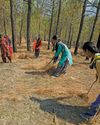
ONE OF the 14 kharif crops for which the Centre releases a minimum support price (MSP) every year is an unlikely plant called niger or ramtil (Guizotia abyssinica). This lesser known oilseed commands one of the highest MSPS, fixed on the basis of the cost of production and market demand. Yet, the area under its cultivation has been steadily shrinking over the past three decades. In 1985-86, niger was cultivated on around 0.6 million hectares (ha), as per a 2013 report by the All India Coordinated Research Project on Sesame and Niger (AICRP), Jabalpur. In 2020-21, the cultivated area shrunk by 80 per cent to a little over 0.1 million ha, the lowest among the 14 kharif crops with MSP. Paddy, the most widely grown kharif crop, is cultivated on almost 40 million ha (see 'High price, low interest' on p18).
The primary reason such a sparsely grown crop is part of the exclusive MSP list is because niger seed has traditionally "been the lifeline of tribal agriculture and economy in several states across India", states the 2013 AICRP report. The tribal population uses niger seed oil for cooking, the press cake post oil-extractionas livestock feed, and also consume the seeds as a condiment. Niger seed oil has medicinal properties, which is the reason for its commercial demand by the cosmetics, perfumeries and other allied industries.
Besides, the crop can grow on denuded soil and its cultivation method is fairly basic: after the first rain when the soil is moist, farmers need to plough the field and sprinkle the seeds. The crop neither requires much water nor fertilisers and pesticides. Why then are the tribal communities increasingly avoiding the oilseed despite such advantages and government support?
VANISHING ACT
This story is from the {{IssueName}} edition of {{MagazineName}}.
Start your 7-day Magzter GOLD free trial to access thousands of curated premium stories, and 9,000+ magazines and newspapers.
Already a subscriber ? Sign In
This story is from the {{IssueName}} edition of {{MagazineName}}.
Start your 7-day Magzter GOLD free trial to access thousands of curated premium stories, and 9,000+ magazines and newspapers.
Already a subscriber? Sign In

THE CIRCULARITY ARGUMENT
A circular economy can help India achieve its developmental aspirations while following the low-carbon pathway. It will also help address the challenges of waste management, pollution and overexploitation of natural resources. Industries are already innovating to reuse high-volume wastes and have shown that the transition can usher in both environmental and financial windfalls

Banking on flawed drug voluntary licences
The Medicines Patent Pool is pushing for more VLs, but its bad deal with Novartis on a cancer drug shows the pitfalls

Lasting solutions
For the first time, the UN has recognised the role of indigenous communities in tackling aridity. A repository of traditional knowledge India has the wherewithal to lead the way

IMD at 150
India's journey into modern weather forecasting took a decisive turn 150 years ago with the establishment of India Meteorological Department during the British rule. The agency has come a long way since then, shaping the way the country predicts and responds to its diverse climate challenges

Every drop counts
In drought-prone Marathwada region, 14 villages have managed to counter water shortage by budgeting the resource

Threat to survival
Hollongapar Gibbon Sanctuary in Assam faces ecological challenges as railway electrification and hydrocarbon exploration endanger its fragile biodiversity

'Migration is going to be a battlefield'
AMITAV GHOSH is one of the foremost chroniclers of our times. His literary sojourn includes writings on topics that range from languages to climate change to human lives. His latest book, Wild Fictions, brings some of his works on these issues under one title. In a conversation with RAJAT GHAI, Ghosh shares his views on the future of human movement. Excerpts:

Face of future
California wildfires confirm forest fires are intensifying in a hotter world, emitting substantial amounts of greenhouse gases and reinforcing global warming

Friends of the forest
Residents of 30 villages in Uttarakhand establish a model for public participation in saving forests from wildfires

Climate-crazy playbook
Just hours after his second (and final) term began on January 20, US President Donald Trump unleashed 46 presidential actions. Several of these are centred on the US' climate commitments, energy transition, migration and trade policies, and are likely to have negative global implications